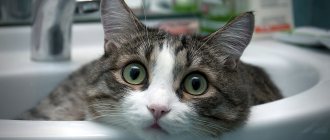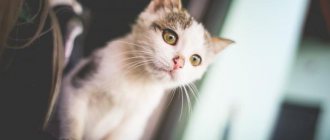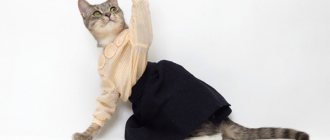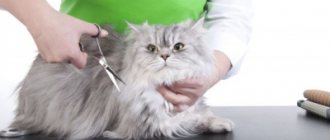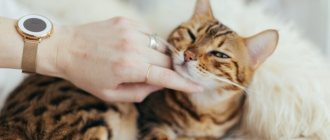The soft, velvety fur of a domestic cat is sometimes exciting to touch. Stroking a cat is a surprisingly pleasant and useful activity for both the owner and the animal. Every living creature enjoys being shown care and attention. However, it would be useful for a person to know how to stroke a cat correctly and when, so that it brings pleasure to both.
Why pet a cat?
Benefit to people
The presence of a four-legged furry in the house itself brings comfort and warmth. When a person returns home, he wants to leave the fuss, troubles, and irritating factors behind the threshold. After petting the cat, he feels a surge of positive emotions, relaxes, calms down, smoothly moving into the comfort zone. Accordingly, this has a positive effect on health - an accelerated pulse returns to normal, relaxation of muscles and vessel walls reduces high blood pressure, and stress goes away. As a result, sleep normalizes. The cat intuitively senses the owner’s mood and “understands” his state.
If a cat lay near a person’s sore spot and purred, the illness may go away.
What benefits does stroking give to four-legged animals?
For cats, such actions are an important part of the relationship. Despite their independent and proud disposition, they love affection, tenderness and attention. When a cat is caressed, the movements remind her of the sensation of being licked by her mother's tongue. From such manipulations, the animal seems to enter a state of light trance, remembering its childhood. In addition, the animal perceives stroking as a massage.
Correct assessment of the situation
In order to “guess” the right time for affection and expressions of love for your pet, you need to learn to understand its behavior:
- If a cat purrs and meows loudly, this does not mean that it is friendly. Pets do not change their behavior because of stroking or for the purpose of receiving additional affection and gaining human attention. Cats can become aggressive and irritable this way.
- If your pet jumps onto your lap on its own, it may be wanting to rest. In this case, the mustachios perceive the owner as a source of heat and warm themselves. They don't want to play or be petted.
- When in a playful mood, the cat will actively rub against its legs, poke its muzzle into its hands and touch them with its paws. The cat lies down next to the owner, begins to stretch out, curls up into a ball, begging for love. In this case, her actions cannot be ignored. Even when you are very busy, you can pet a cat for 1-2 minutes and strengthen your friendship.
Cats have a changeable and independent character, so they can only ask for short-term affection and do not crave long-term communication with humans.
At the same time, animals are vindictive and touchy. If you don't pet them, they will avoid their owner for a long time.
Also watch the video on how to properly pet a cat:
Interpretation in different dream books
In dream books from famous personalities, stroking a cat has the following meanings:
- Miller. Stroking a dirty and unkempt animal means serious troubles that will change the dreamer’s life for the worse. If in a dream you petted a purebred and fluffy cat, minor problems await you in the near future, which you can easily cope with on your own. For single people, such a dream symbolizes unrequited feelings or betrayal in a future relationship.
- Vanga. According to Vanga’s interpretation, stroking a cat most often means a deterioration in relationships with a loved one or problems at work. To avoid bankruptcy, it is recommended to take a closer look at your colleagues and manage your projects yourself. You should have a sincere conversation with your significant other - this will help identify existing problems and maintain harmony.
- Freud. Stroking a furry pet, according to a famous psychologist, symbolizes the desire for intimacy on a subconscious level. Also, such a night vision can warn of betrayal of a loved one, strong jealousy or a short love affair that will leave the dreamer with negative emotions.
- Nostradamus. In the dream book of Michel Nostradamus, stroking a cat means ingratitude or betrayal of one of the family members. If in a dream you caressed many little kittens that purr with pleasure, an influential person will appear in real life, and he will become a support in all your endeavors.
- Meneghetti. Monotonously stroking a pet means there is an energy vampire in your immediate environment. The presence of this person provokes a deterioration in the psychological and physiological state of the dreamer, so it is recommended to identify this person as soon as possible.
- Hasse. The medium warns that petting a cat in a dream is a sign of excessive gullibility in real life. To achieve success in future projects, you need to learn to understand your colleagues and not let employees know your ideas. If the animal looks sick, you need to pay more attention to your family, as they are in dire need of your support.
- Medea. A dream in which you stroke a cat warns of the onset of a black streak. In the near future, all the dreamer’s actions will be negatively perceived by people around him, so it is recommended to refuse drastic changes in work or personal life. The sorceress recommends taking a short vacation and spending it alone with yourself.
Each person has a different attitude towards cats and cats, but the appearance of the image of this animal in a dream often warns of possible troubles or drastic life changes. To avoid negative consequences, it is recommended to listen carefully to the sensations caused by the dream and try to avoid rash actions.
When can you pet a cat?
An observant owner, knowing the temperament of his pet, sees when he wants affection and when it is better not to touch him. At times the animal rubs against objects, taps its tail or purrs. This does not necessarily indicate that the kitten wants to be petted. In this way, the pet can show interest, greeting or irritation. An attentive owner, observing behavior, will know exactly when the animal is in a happy state and is ready to be petted. The main thing to remember is that this cute creature is not a plush toy, but a whole separate world with its own life cycle and desires.
Stomach
Another place that brings pleasure to cats is the stomach. You should only stroke his belly if the cat himself asks for it. Cats are animals that are very careful. Lying on their backs, they are very vulnerable, therefore, they do not always readily accept stroking in the abdominal area. Only when the cat feels that he is safe can he allow stroking in this place.
If you have noticed, dogs can often lie down in front of a person to have their belly rubbed, while cats, on the contrary, will never lie down on their backs in front of a stranger. Stroking the belly is a special privilege that is available only to those people whom the cat knows well and will completely trust. Such people usually include members of the family in which the cat lives.
© shutterstock
Dream Interpretation - Cat, cat, kitten
Cats in a dream mean petty thieves, envious people, slanderers, or illness and worry. Getting rid of a cat or killing it in a dream is a sign that you will catch a thief or overcome a disease. Fighting with a cat in a dream means illness. If she scratches you, your illness will last longer than you think. Eating cat meat or skinning a cat is a sign that you will not miss the opportunity to profit at someone else’s expense. Seeing a cat's skin in a dream means the return of what was lost. If you dream that many cats surrounded you, then beware of intrigue, slander and envious people. Kittens dream of illness and everyday squabbles. If you tear the kitten away from you and throw it away, then everything will be fine. If he scratches you, you will get sick or lose money. A white kitten cuddling up to you in a dream serves as a reminder of loved ones who are in dire need of your help. Especially if the animal was bleeding. If you refuse support or help at this moment, you may lose this person forever. A black cat in a dream, just like in life, does not bring good. If you see him in a dream, expect misfortune. A cat in a dream means seducers who encroach on the honor of your wife. Seeing in a dream how a wild animal tore a kitten to pieces means that your enemies will not share something among themselves, which will be very useful for you. Watching a cat fight with a dog in a dream is a sign of protection and help in a difficult situation. Eating cats in a dream is a sign of betrayal. See interpretation: Animals, Blood, Purring.
How to iron correctly?
Conventionally, the owner’s behavior can be divided into the following stages:
- Before active actions, you need to warn the cat about your intentions by bringing your palm closer to its muzzle and allowing it to sniff.
- If the fluffy reacts calmly and rubs against your hand, then he is ready to continue.
- It is better to start gently stroking behind the ears, scratching the neck and chin. Gradually move from the head to the back.
- Each individual has favorite places for ironing, which the cat shows with all its appearance and asks for. Having identified these zones, there is no need to skimp on affection and tenderness.
- If a four-legged animal turns away, moves away, and begins to scratch, we must respect its “opinion” and freedom, and not cause more aggression. There is no need to touch a sleeping cat.
- Do not forcefully stroke an angry kitten with your hands, otherwise it will try to bite or scratch.
How cats perceive affection
The owner shows concern when the pet has a desire to receive affection from a person. This gesture contains a piece of respect for your cat and the animal’s personal space. Most pets cannot tolerate prolonged petting and stroking. After 2-3 minutes of continuous purring, they can suddenly change their friendly behavior to aggression.
As a result, the owner will have a couple of extra scratches and bites.
If you do not train the cub at the growing stage, then sudden changes in mood cannot be corrected.
Cats are more selfish and independent compared to dogs, so they do not intend to tolerate discomfort.
The animal is overfed
Many owners simply pour dry food into a bowl and allow the pet to eat as much as it wants, adding more as it becomes empty. There is nothing wrong with this, because cats by their nature are not predisposed to overeating. But sometimes “the settings go wrong” and the animal loses its sense of proportion. The reasons for this may be different:
- experienced a period of hunger or malnutrition;
- excess carbohydrates in the diet (sudden surges in blood sugar spur appetite);
- food that is too tasty and difficult to stop eating;
- hormonal changes, taking certain medications.
Cats prone to obesity need to strictly ration the amount of food they eat. If you use ready-made complete food, there will be no difficulties with calculating the diet: all the necessary information is already on the packaging. On our foods it is presented in the form of a table, with a separate column for overweight cats.
When measuring food, you should use a branded cup or an accurate kitchen scale. Cat portions are very small, so even an error of 10–15 grams can interfere with weight loss
Also note that the indicated dosages are calculated per day, not per feeding.
When feeding homemade food, the diet must be individualized
It is important to take into account not only the energy value, but also the distribution of macronutrients (proteins, fats, carbohydrates)
Pleasant areas for stroking
Head and back of the head
The favorite place to touch is the head, in particular, if you scratch behind the ear, you can hear a purr. Almost all cats love affectionate touches on the head. Kittens remember that this is where their mother licked them. These pleasant sensations remain in the subconscious for life. Sitting comfortably on your hands or knees, the cutie will gratefully accept the love of his owners if he is scratched behind the ears and the back of his head. The cheeks are especially sensitive - the area behind the mustache below the eyes. By lightly patting this area, you can hear purring.
Breast and neck
With gentle movements of your fingers, moving from the chin to the neck, you can observe how the cat is pleased, and he stretches his neck forward, submitting his palms and squinting his eyes. These areas are located in such a way that it is difficult for a cat to comb them out on his own, so help is simply necessary here. He will not refuse several repetitions of the slow combing procedure, hinting at continuation.
Back and sides
Wide, gentle movements of the palm from the head to the base of the tail along the spine will demonstrate care. After all, such a massage relieves muscle spasms and stress on the back. Arching the body and rubbing the forehead on the hand encourages the owner to repeat what the cat liked. The paws remain controversial areas. Here the reaction may be different. It must be carefully clarified and conclusions drawn.
The best places for stroking
Felinologists and veterinarians identify several areas that are the best for stroking a cat, namely:
- The back of the head and the area behind the ears . Gentle massage movements with gentle pressure on the body are suitable for people who have recently bought a pet and do not yet know about its preferences. You should walk your fingers from one ear to the other, lingering at each for 1-2 minutes. After 40-45 seconds, the cat will begin to meow and purr, adapting to the person’s hand.
- Cheeks . Some animals love to be stroked with fingertips in the vibrissae area and under the eyes.
- Along the hair growth from the base of the neck along the back, excluding the tail area . A positive reaction of an animal is considered to be the moment when it arches its back and rubs its muzzle against the owner’s hand. This gesture means that the cat wants to receive affection for a long time.
- Chest and neck . These are areas of increased sensitivity, when touched, the cat reacts friendly and asks for more affection. You need to start with light stroking with your fingertips from the chin to the chest and neck. If your furry pet likes them, he will begin to purr and stretch his neck as much as possible.
- Paw pads. They contain many nerve endings, making them one of the most sensitive parts of a cat's body. A small number of individuals enjoy having people rub their paws up and down. If your pet does not like the massage of the pads and stroking, he will easily take the limb back.
Head
Almost all cats don't mind having their heads stroked. But, try not to touch their ears with your hand. This is a special and very sensitive organ, the touch of which is not very pleasant for the cat. One of the places that brings the most pleasure for almost all cats is the upper part of the bridge of the nose and forehead. Gently stroking your fingers in this place has a very beneficial effect on the cat. The thing is that this is the point at which in childhood, each kitten is licked by the mother, washing them. Apparently, these pleasant memories are embedded in every kitten on a subconscious level, therefore, when stroked in this place, they experience very pleasant feelings.
© shutterstock
The most sensitive places on a cat's body
Many people pet cats incorrectly and do not take into account that there are very sensitive areas on the body that touching will bring pleasure or cause discomfort.
If you manage to find the most “sweet spots”, you can even say erogenous zones on the pet’s body, in this case you can do whatever you want with the animal and you won’t get anything for it, even if the cat is not in the mood.
Area near the ears
One of the most sensitive areas in cats is between the ears and eyes (where the hair is thinner, shorter). Cats go crazy if you pet them there, they themselves turn their faces or rub their heads against the owner. A large number of odorous glands are concentrated in these places.
Chin
Many cats love to have their chin stroked, especially the base, and their neck gently touched. For maximum pleasure, strokes should be gentle, careful from the base of the chin to the neck.
Cheeks
There are many scent glands and receptors located on the cheeks. Stroking the cheeks towards the neck gives cats literally ecstasy, and if you are careful and gentle, the pet will purr like a tractor. But do not forget that whiskers grow here and if you handle them carelessly, the cat will show character.
Pet the cat behind the ears
Cats experience wild delight when the owner strokes the area behind the ears or at their base. The pet will purr contentedly, rub its head, and cuddle its body against you.
Back, sides
In terms of sensitivity, the back of a cat is somewhere in the middle. According to research, it is noted that the reaction of cats to stroking the back does not depend on which direction the animal is stroked (from head to tail or vice versa). More sensory receptors are located on the back from the middle of the body to the base of the tail.
The sides of cats are also sensitive to tactile contact and many cats offer the side for gentle caresses.
Tail
The cat's tail is highly sensitive and is one of the important parts of the body. Helps with communication, hunting, and is necessary for maintaining balance. By the position of the tail, the owner can determine the mood of the pet.
But if you stroke a cat's tail, the reaction may be ambiguous.
Some are lenient and patient with such manipulations, others cannot stand it when the tail is touched.
Paws and paw pads
A cat's paws are also sensitive areas. Thanks to a large number of receptors, felines literally sense the world through them.
Soft, graceful paws just beg to be stroked.
Some cats allow their paws to be stroked or at least tolerate being touched, while others will immediately bite if touched.
Try gently massaging the pads of the back paws. If the cat does not show dissatisfaction, lies calmly, spreads his fingers like a fan, rest assured, the pet is delighted.
Tummy
The stomach of cats is a very sensitive area of the body. Despite the absence of secretory zones, many very sensitive areas are localized here. Therefore, do not be fooled if the furry one lies on its back, as if exposing its belly for caresses, or sometimes allows you to touch its furry belly.
In any case, do not overdo it, do not hold your pet by force, no matter how much you want to caress it. Before petting your pet, assess its mood and emotional state. If the cat is excited or not in the mood, reschedule the tenderness session to another time.
Why can't you pet your tail?
This part of the body is responsible for several functions:
It is not recommended to touch the tail, as it contains nerve endings and touching it causes discomfort to the animal.
- coordinates movements;
- shows the emotional state of the moment;
- In some breeds it serves for additional heating.
It is not recommended to stroke the tail and its base. Touching causes irritation, nervous movements, and sometimes outright aggression or an attempt to claw at the animal. There are many nerve endings passing through here, and their activation brings considerable discomfort to the animal. The back can be stroked only to the base of the tail, without trying to touch it.
Steps
Pay attention to areas with scent glands
- Start by scratching your neck.
- First, let your cat sniff you so that she stops being afraid.
Reach out your hand or finger and let your cat touch your nose.- If the cat does not show interest in the hand or simply looks at it incredulously, it is better not to pet the animal. Try doing the same at another time when your cat's mood changes.
If your cat sniffs your hand, meows, and begins to rub its face or body against you, it is most likely ready for petting. Open your palm and lightly touch the animal.
- Wait until the cat begins to rest its head on you.
If a cat rubs its head, it means it wants attention. If you're busy, at least pet her a couple of times so she knows you're not ignoring her.Pet your cat once if she jumps onto your lap and lies down.
Pay attention to whether the cat is spinning on its knees. If so, she may be looking for a more comfortable place and wants to lie down because the human body gives off heat. If she is lying quietly, you can gently stroke her back or in the places discussed below.
Pet your cat while she is lying on her side.
Cats love to be petted in this position. Run your hand along the side that faces up. If a cat meows or purrs, it means she is feeling good.
- Do not touch the cat's belly (this will be discussed in more detail in the third part of this article, step 3).
- Listen to sounds (rumbling).
With the help of purring, a cat communicates its readiness to communicate with a person and that it wants attention. If the cat pushes you with its head, hips or curls at your legs, it means that it wants you to pet it right now. Sometimes a cat wants one touch as a greeting rather than a long hug.- The volume of the purr indicates how pleased the cat is with your actions. The louder the purr, the more the cat likes what is happening. A weak rumbling indicates that the cat is happy, and a strong rumbling indicates that the animal is very happy. If your cat purrs very loudly, this may indicate excessive joy, which sometimes turns into irritation, so be careful.
- Look for signs that your cat doesn't want to be petted anymore.
Sometimes even pleasant strokes and touches can cause irritation, especially if they are repeated often. If you don't notice this irritation in time, your cat may bite your hand lightly or scratch it. However, most often before you bite, the cat makes it clear several times that she does not need to be petted anymore. Pay attention to the following signs, and if you notice them, stop stroking:
- Don't touch your stomach.
When the cat is relaxed, it can turn onto its back with its belly up. Don't take this as a request for a belly rub, because most cats don't like it very much. This is because in nature, cats must be cautious and protect themselves from predators (unlike dogs, who are more confident and allow belly rubs). The belly is a vulnerable area where vital organs are concentrated, so many cats instinctively extend their claws and bare their teeth if someone touches their belly.- Some cats enjoy this, but see it as an invitation to fight using claws and teeth, or an invitation to rough play. The cat will grab your hand with its claws, bite it, or scratch it with its back or front paws. This should not always be considered an attack - cats often play like this.
If the cat grabs you with its paws, freeze and let it release you. If necessary, open the cat's paws with your other hand. Sometimes the claws get stuck and deep scratches remain on the body, even if the cat doesn't want it. Cats use their claws to grab and hold objects, so when a cat grabs you with its paws, it means it wants you to stop. If you stop, the cat will stop digging its claws into you.
- Paws should be touched with caution.
Don't play with the cat's paws unless you know the cat very well and that she likes to have her paws touched. First, pet your cat to help her relax, and then ask her permission to pet her paws by touching each paw with a finger.- If your cat doesn't object, gently stroke the paw with your finger in the direction of the hair growth (from the wrist to the toes). If the cat withdraws its paw, hisses, flattens its ears, or decides to leave, stop trying.
Many cats do not allow their paws to be touched, but they can be trained to do things like nail trimming if they are trained regularly using treats as rewards.
Use your fingertips or nails to gently scratch your cat's neck, especially where the jawbone meets the skull. Perhaps the cat itself will reach out to you or throw back its head. All this will indicate that she is pleased.
Pet your cat between or behind the ears.
Use your fingertips to press lightly on your head. There are also scent glands at the base of the ears. If a cat pushes its head, it is marking you as its territory.
Stroke your cat's whiskers.
If your cat enjoys this type of touch, she will turn her whiskers forward to encourage you to continue petting her.
Gently run your hand over your cheek.
Once your cat is used to your touch, run your middle finger along the whiskers (above the mouth) and along the cheek, and stroke the head with your thumb. That's it, the cat is now yours!
Stroke the cat from head to tail.
Run your hand over your head, then from the crown to the tail. Do this several times. Knead the cat's neck muscles with light massaging movements. Apply gentle pressure to your neck and make several slow movements. You should only stroke your cat in one direction (from head to tail), as many cats do not like to be stroked against the grain.
Let your cat come to you
Know what not to do
- Stroke the cat from head to tail, but not vice versa.
Some cats don't like being stroked against the grain.
Don't pat the cat.
Some cats like it and some don't, so if you don't spend a lot of time with the animal, don't risk it or your cat might scratch or bite you.
A cat is the most domestic, most affectionate creature that creates comfort in both a large mansion and a small room. People who love these animals claim that they are perfection, exude peace, bring good luck, happiness, wealth, people become kinder and more tolerant. They know how to love, heal, save from loneliness, be devoted and faithful.
Many patients and doctors admit that having a cat in the house improves the course of a variety of diseases. Cats have helped people suffering from serious mental disorders, heart disease, strokes and paralysis. Cats saved alcoholics and drug addicts from addictions. So what is the healing power of a cat? Since cats are proud and independent creatures, feline disposition is more valued by owners. When a cat shows its love, a special psychological connection is established between it and its owner. Cats are always sincere. Unlike people, they never deceive or flatter. Cats express their devotion by rubbing their legs, arching their necks under their fingers, and purring affectionately.
Cats are excellent touch responders. Human skin is the most sensitive organ. The skin of an adult makes up 6-8% of the total body weight. Each centimeter of skin contains up to 4 million cells and about 100 nerve endings; in total there are 640 thousand sensitive receptors on the skin. Without the constant feedback provided by the skin, the brain will not be able to force the muscles to respond to external influences. When an arm or leg goes numb, it makes it much more difficult to move the limb due to the lack of tactile responses. Even during sleep, the sense of touch continues to play an important role. Therefore, satisfaction from touch is a very important factor for a person’s physical, emotional and mental health. The most primitive reaction to a gentle touch: you get the feeling that you are not alone in this world, and the body relaxes. If a person does not receive enough tender touches from loved ones, pets can partially fill this need. But even if a person feels enough affection in the family, a beloved pet can enhance the healing effect of tenderness. Of all pets, cats are most likely to respond to slow, gentle stroking, and cats also have soft, delicate fur. As healers, it is best to use calm, friendly animals that demonstrate their devotion and sympathy to the owner by constant readiness for affection. These cats love to rub against your legs, climb into your arms, and purr when stroked. Do not deny your cat affection, and in return she will give you good health and longevity! But even if your pussy has a nervous character and does not give in to your hands, do not be upset. Watching the graceful movements of a cat and being touched by cat antics can greatly improve the mood of any person. Animal-assisted therapy is the treatment of humans through communication with animals.
It is known that cats are attracted to negative energy; they seem to absorb it. When any disturbances occur in our body or around us, it senses it and rushes to that place. The cat is designed in such a way that it needs this “recharging”. Each of us has observed how cats love to be near electrical appliances that emit negative electromagnetic waves. A person, on the contrary, in order to get rid of ailments, needs to remove negative energy. So, a cat is just a gift for him, a home healer. Observations showed that:
Black cats “take on” negative energy twice as much as other colors.
Cream cats tone up the owner’s energy
Red cats give off positive energy the most
Gray-blue cats - calm, neutralize
White cats, in general, are considered medicinal for all the listed indicators (in England, white cats are sold in special pharmacies, where specialist animal therapists sell them like aspirin or other drugs)
It must be said that cats treat different diseases in different ways. Having found a sore spot, some lie down on it, trying to warm it up. Others, having released their claws like an acupuncturist’s needles, begin a kind of massage. As a rule, the therapeutic effect occurs at the first rumbling and purring sounds, which soothe and relax. At these moments, it is not advisable to push the cat away, but rather to switch gears and calm down. It will extinguish the “storm” of your body.
Scientific studies have been conducted on the topic of the healing abilities of cats that have shocked scientists. It has been found that petting a cat for a few minutes normalizes a person's blood pressure and reduces the risk of recurrent stroke and heart attack. The condition of the patients after the experiments was similar to the state of health after a session of meditation and relaxation. Our skin is directly connected through nerve receptors to the brain. By petting a cat, we transmit signals to the brain through the skin of our fingers. We experience a feeling of relaxation and calm. When a cat or dog is caressed and the owner strokes its fur, this is nothing more than an electrostatic effect with weak currents. All physiotherapy today is based on the impact of weak currents on us. So a cat is essentially a home physiotherapy device. And traditional Eastern medicine is precisely based on the connection between the nervous system and individual areas of the body and skin. And everything in our body is subordinated to the nervous system. And through it you can indirectly influence internal organs. And this is already real reflexology.
I would like to note that by forcibly holding a cat next to you you will not get a therapeutic effect. There must be a close relationship of trust between the owner and the cat. And if at the same time the cat starts purring and shows that she likes to be with you, the effect increases several times.
A cat's purring does not necessarily express the cat's emotions. It helps her self-medicate: heal wounds and strengthen bones. This conclusion was reached by North Carolina scientists who studied cat sounds. The sound range of a cat is from 27 to 44 Hz. Scientists have suggested that purring is similar to ultrasound treatment. It was found that exposure to sounds in this range increases wound healing, bone growth and strengthening. If you have watched a cat, then remember the fact that after a fall, injury, and during childbirth, they purr. It is believed that in doing so they relieve pain and heal themselves. Wounded cats are known to purr while licking their wounds, which may be why they survive even after falling from tall buildings. The Journal of the American Veterinary Medical Association provides data according to which out of 132 cats that fell from the average height of the sixth floor, only 14 died. And one even survived a fall from the 45th floor. Scientists see this as purring can be used to treat osteoporosis, especially in older people, because They cannot do physical exercise.
Professor Clinto Rubin found that exposure to sound in the range of 20-50 hertz increased height and strengthened bones by 20 percent. For example, chickens placed on a vibrating stand for 20 minutes a day grew faster and had much stronger bones than their normal counterparts.
However, the cats' talents don't end there. It has been found that communication with a cat has a beneficial effect on patients after severe injuries, suffering from mental disorders, cardiovascular diseases and strokes. Recently, in the West, cats have been used to relieve stress and treat drug and alcohol addiction. Long-term observations of doctors have shown that the biological impact of cats is stronger than that of cats. Cats are “better” at treating diseases of the nervous system and internal organs. Cats are excellent healers of osteochondrosis, radiculitis, and arthrosis.
Long-term observations of cats suggest the following fact: different breeds have their own area of healing. For example:
Long-haired cats (Persian, Angora, Siberian, Ragdoll, Burmese, etc.) are neurologists, help with insomnia, irritation and depression.
Shorthairs with plush hair (exotic, British, Scottish, Russian Blues, etc.) - “specialize” in cardiovascular diseases
Cats of short-haired and hairless breeds (Siamese, Oriental, Sphynx, etc.) treat diseases of the liver, kidneys, gastritis, colitis.
At the Berlin Institute of Gerontology, a group of seven scientists conducted a study on the effect of cats on the life expectancy of their owners. Findings from this five-year study of more than 3,000 cat owners showed that people who have owned a cat throughout their lives live an average of 10.3 years longer than those who are cat-free. Pet owners have better blood pressure readings than the other half of humanity. And, what’s very strange, the level of cholesterol in the blood, one of the risk factors for heart attack, is lower. According to gerontologists, cats are a real elixir of youth for their owners.
At the same time, never forget that only a friendly, healthy cat can have a beneficial effect on your body.
Margaret Woodhouse (loosely translated)
Full face
Ancient manuscripts clearly indicate where your cat's purr points are located. Nothing upsets a Subject more than poorly targeted touches. (This, moreover, can be quite dangerous for the Masseur).
- Drum
- Comb brush
- Chit
- Internal side step
- Flamenco guitar
- Chin lift
- Piston
- Whipped cream
- Ticklers
- Interstitial cross
- Brass knuckles
Rear areas
It is worth noting that there are much fewer critical points on the Object's back. This reduced sensitivity may be explained by the complete inability of many objects to shoulder responsibility.
- Terochki
- Let's dance limbo
- Door bell
- Fern
- Firecracker
- Double dose
- Dump truck
Murrometer and posometer
It is not so easy to assess how much pleasure a cat gets. It is for this purpose that we have developed a system of indicators - a modern, but already proven addition to the art of petting cats.
Each murr point receives an assessment based on two indicators at once. The massage therapist should evaluate both audio and visual feedback. So, for example, a score of 2 on the murrometer can be combined with perfect bliss on the posometer scale, which increases the average score to 4.
| Purring is measured with a murrometer on a scale from I to V. | The second indicator scale is a posometer. Since some Objects do not purr at all, this system helps to make a pleasure rating based on visual cues alone, similar to the purr level. | |
| I-II Moped – Felt by only a few massage therapists, mainly those wearing thin clothing. | 1-2 – Pleasant relaxation | |
| III Harley-Davidson – Experienced by almost all massage therapists. Accompanied by almost imperceptible movement of the Object. | 3 – Soft pleasure | |
| IV Corvette – Felt by all massage therapists without exception. There is a noticeable change in the Object's pose. The fur rises slightly. | 4 – Contentment | |
| V Dump truck - You can hear it even through the pillow. Claw injuries are possible. Almost none of the massage therapists sit still. | 5 – Perfect bliss | |
Precautionary measures
Before proceeding with full-scale caressing, the massage therapist should remember the following dangerous claw points:
You should not stun the Object with too energetic movements (the exception is the Firecracker).
Do not attempt to use techniques against the grain unless otherwise instructed.
If you do hit a claw point, NEVER jerk your hand away suddenly.
It seems that cats are simply created to be petted - these fluffy creatures are so cute and beautiful. But many people forget a rather obvious fact - this is not a toy, but a living creature, and if you can squeeze and caress a plush toy in any way, then you still need to show some care, tact and understanding regarding the cat.
Of course, instructions on how to pet a cat may seem quite funny at first, but this information really deserves attention and study. Therefore, we will try to understand what is the peculiarity and essence of stroking your furry pet.
Why do cats purr?
You've probably noticed that when a cat is happy and satisfied, it begins to make unusual sounds, that is, it purrs. Why and why she does this at a certain moment, even scientists are not able to determine exactly, but there are several interesting theories on this matter.
However, before answering the question posed above, it is necessary to find out what the very principle of purring of any cat is. According to scientists, the whole point lies in the generation of electrical impulses that are located in the animal’s cerebral cortex. It is from there that they are transmitted through the central nervous system to the muscles, causing them to contract (by the way, they are located near the vocal cords).
The mechanism itself is located between the skull and the base of the tongue - it consists of thin hyoid bones, which begin to resonate as soon as the muscles that we wrote about just above begin to contract. All this leads to the so-called purring. It is worth noting that the sound itself comes only from the animal’s nose and mouth, but the vibration spreads throughout the body. That is why, when we press our hand to, say, a cat’s belly, we feel its rumbling. As you can see, the mechanism is very simple, if you understand it properly.
First of all, the animal shows such signs and tells us that it is well-fed, healthy and happy. It's easy to check - just pet your pet. Almost immediately she will begin to make purring sounds. Or feed her boiled chicken. Or... In general, you probably know many ways to please your pet.
Cats that have fallen asleep often purr. For what? It's simple - in this way they show their children that everything is in order and there is no need to worry. In turn, the kittens respond to their mother in the same way - they say, everything is fine. And also
Source
The cat Sima is two years old. Lately she has started biting her owners just for fun. He’ll come up and bite out of the blue. Why is she doing this?
Many cat owners have experienced such strange behavior from their pets, when the cat suddenly bites the hand of the owner stroking it and runs away. This aggressive reaction can be caused by asserting one's independence and, for various reasons, can manifest itself as a response to affection.
What are the reasons for this behavior? Cats are not as socialized animals as dogs; even with members of their own species, they rarely come into physical contact. It’s not for nothing that they say that a cat walks on its own. Sometimes cats can lick each other and sleep cuddled up to the warm side of a neighbor, but this is usually where their contacts end. Affectionate stroking is something alien, not typical of these animals.
Incorrect socialization. Cats should be socialized to people from a very early age. Cats that have interacted with a person for at least 5 minutes a day before the age of seven weeks will be much more affectionate and trusting than animals that have not met a person at this age. But this theory does not explain why properly socialized cats sometimes become aggressive towards their owners.
Sensitivity threshold. According to this theory, cats initially enjoy being petted by people, but then become irritated by it. And when a cat bites its owner, it’s as if it’s trying to say “enough is enough.” Here we can draw an analogy with human behavior. Imagine that someone is patting you on the back. At first you like it, but then you get tired of it and you want to move away from that person or ask him to stop.
Pain. There is a theory that constant petting not only causes irritation in animals, but also physical pain, since the static electricity generated by stroking
Source
Where should you not touch a cat?
If the pet lies on its back, showing a soft belly, then it shows complete trust and openness. This is a very vulnerable area and is available for petting only after the invitation and permission of the cat. He doesn't like patting his belly and is more likely to lead to play with biting and scratching. Do not move in the direction opposite to hair growth, lifting the hair with force.
You should not stroke your cat against the grain, as this causes pain, especially in short-haired cats.
A defensive reaction occurs instinctively - the cat attacks, bites, scratches, and sometimes hisses. Any representative of the cat family would not want to feel discomfort from touching the delicate and sensitive ears. The ears help to choose the direction of movement. They are equipped with a rich nervous network. Even a light breeze causes the cat to shake its ears.
What not to do
There are 3 basic rules that must be followed in order not to irritate your pet:
- Don't touch your stomach . Unlike dogs, cats do not like to have their abdominal area touched. Pets in the sun stretch out and lie on their backs, which is why a person may misinterpret their behavior. The belly is considered a vulnerable part of the body, which the cat will actively defend. If a cat has a good relationship with its owner, and it knows for sure that the person will not cause harm, it can allow itself to be stroked on the stomach. If the purr is in a bad mood or does not have close contact with the owner, then predatory instincts awaken in the pet - it roughly grabs the owner’s hand with its paws with extended claws and bites hard (read more about why a cat bites when you pet it).
- “No” to rudeness and sudden painful movements . Human touches should not be rough or too active. The pet perceives intense and sudden movements as a threat, which is why it can become aggressive.
- Do not iron against the fur. It is not recommended to run your hand against the growth of the fur. Representatives of felines take care of their coat, so they do not like to be ruffled.
Owners should not overly pamper their cat with constant, lengthy petting. Love is shown in sufficient quantities - the pet should not distract the owner from business with impunity.
Useful tips
There are several rules regarding how to properly pet a cat:
- It is not advisable to pet a cat if he does not want to. Also, you cannot hold your pet by imposing your affection on him.
- Before you start petting, it is important to make sure that the cat is in a good mood. If the animal growls threateningly, its ears are flattened, and its tail flickers from side to side, then it is better to retreat. It is important for the pet to understand that his wishes are respected.
- You should not pet a frightened cat. Such a gesture will only increase her stress. It is better to talk to the animal in a quiet, measured voice. The cat will calm down faster, and the owner will have the opportunity to comfort him with gentle strokes.
- You should not pet your cat while eating, sleeping, or sitting in the litter box.
- Cats do not like eau de toilette and scented cosmetics. After using these means, it is better not to touch your pet.
- You cannot pet a cat while hanging over him with your body. Also, you should not look directly into his eyes for a long time. It is advisable to sit in a chair or on a sofa and wait for the animal to come and lie down next to you.
- Animals love to have their paws and pads stroked. But not all! These are very sensitive places. You need to touch them gently and carefully. If the cat is not delighted with such caresses, the owner will know about it immediately.
- The cat itself jumped onto your lap - a good sign. But you shouldn’t start petting her right away. Often she comes to lie relaxed on the warm lap of her owner and, when he starts petting her, she gets offended, jumps off and leaves.
- Before petting, it is useful to play interactive games with the cat (10-15 minutes), using 2-3 toys. The animal will warm up, release accumulated energy and negative emotions, and perhaps with gratitude and pleasure ask the owner for affection.
- You cannot pet a cat after punishment. She will regard this gesture as encouragement, a sign of weakness on the part of the owner. In the future, the animal will also misbehave and manipulate people.
- Sometimes cats rub against their legs. But this is not a call for stroking, as many people think. So he marks a person with a smell like “his territory.”
Information on how to properly pet cats will help you avoid many problems. Awareness will bring mutual pleasure and benefit to the human body who regularly caresses his pet.

